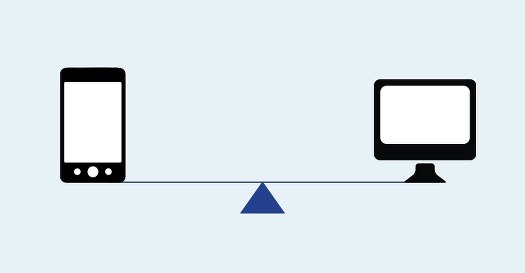Mobile vs. Desktop Advertising: Pros and Cons
In the ever-evolving digital landscape, advertisers must strategically decide between mobile vs desktop ads to reach their target audience effectively. Both mobile and desktop advertising have unique advantages and challenges, and understanding these can help you optimize your ad campaigns for the best results. Here, we break down the pros and cons of mobile and desktop advertising to help you make an informed decision.

Mobile Vs Desktop Ads : Mobile Advertising
Mobile ads are a crucial part of digital advertising, reaching users on their smartphones. They come in formats like display, video, and native ads, offering creative ways to engage audiences. With location targeting, mobile ads can deliver personalized content in real-time. As mobile usage grows, optimizing ads for mobile devices is essential for advertisers. Comparing mobile vs desktop ads may seem tricky, given both platforms have wide audience and nearly everyone uses a smartphone in 2025.
Pros:
Wide Reach:
- Mobile devices are ubiquitous, with billions of users worldwide. Mobile advertising allows you to reach a broad audience, including those who primarily use their smartphones and tablets for internet access.
Location-Based Targeting:
- Mobile ads can leverage GPS technology to deliver location-specific messages, offering more personalized and relevant advertising opportunities.
High Engagement:
- Mobile users tend to be highly engaged, often using apps and browsing the web multiple times a day. This frequent interaction increases the chances of your ads being seen and interacted with.
Push Notifications:
- Mobile devices support push notifications, which can be a powerful tool for delivering timely and direct messages to your audience.
Social Media Integration:
- Social media usage is predominantly mobile. Advertising on platforms like Facebook, Instagram, and Snapchat can be more effective when targeting mobile users.
Cons:
Limited Screen Space:
- Mobile screens are smaller, which can restrict the amount of information you can display and make it challenging to create visually appealing ads.
Ad Blockers:
- The use of ad blockers on mobile devices can reduce the visibility of your ads, affecting your campaign’s reach and effectiveness.
Short Attention Span:
- Mobile users often have shorter attention spans and may quickly scroll past ads. Capturing and retaining their attention requires highly engaging and concise content.
Varied Operating Systems and Devices:
- The diversity of mobile devices and operating systems can complicate ad design and targeting, as ads must be optimized for different screen sizes and capabilities.

Mobile Vs Desktop Ads : Desktop Advertising
Desktop ads are effective for driving high CTR and ad traffic, especially for detailed content. With larger screens, they provide more space for engaging visuals and information. Users tend to spend more time browsing, making desktop ads great for conversions. While mobile ads are growing, desktop ads still play a vital role in many campaigns.
Pros:
Larger Display Area:
- Desktop screens provide more space for detailed and visually rich advertisements, allowing for more comprehensive messaging and better design flexibility.
In-depth Content Consumption:
- Users tend to spend more time on desktops when conducting research, reading articles, or engaging with long-form content, providing opportunities for more in-depth advertising.
Better Ad Visibility:
- Desktop users are less likely to scroll quickly past ads, and the larger screen size enhances the visibility and impact of your ads.
Advanced Targeting Options:
- Desktop platforms often offer more sophisticated targeting options, enabling precise audience segmentation based on demographics, interests, and behaviors.
Higher Conversion Rates:
- Desktop users are often more likely to complete purchases or fill out forms, leading to higher conversion rates for e-commerce and lead generation campaigns.
Cons:
Declining Usage:
- While still significant, desktop usage is declining as more people shift to mobile devices for their internet needs, potentially reducing the overall reach of desktop ads.
Fixed Locations:
- Desktop advertising lacks the mobility and real-time location targeting capabilities that mobile advertising offers.
Less Frequent Interactions:
- Desktop users may interact with their devices less frequently throughout the day compared to mobile users, resulting in fewer opportunities for ad impressions.
Ad Blockers:
- Like mobile, ad blockers are also prevalent on desktops, which can hinder the visibility and effectiveness of your ads.
Conclusion
Both mobile and desktop advertising have distinct advantages and challenges. Mobile advertising excels in reach, engagement, and location-based targeting, making it ideal for reaching a broad audience on the go. Desktop advertising, on the other hand, offers larger display areas, higher conversion rates, and better visibility, making it suitable for more detailed and impactful campaigns. Choosing mobile vs desktop ads may prove difficult since both platforms are highly engaging and let’s say its just hard to choose. But, the decision must be made according to the strategy, budget, goals, and action plan.
The best approach is to consider your specific business goals, target audience, and the nature of your ad content. A balanced strategy that leverages the strengths of both mobile and desktop advertising can maximize your campaign’s effectiveness and reach. By understanding the pros and cons of each platform, you can make informed decisions and optimize your advertising efforts for the best results.








Leave a Reply